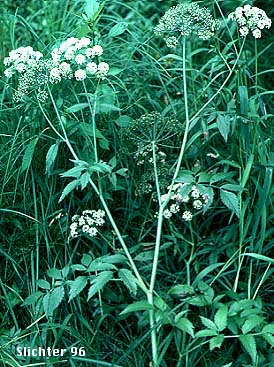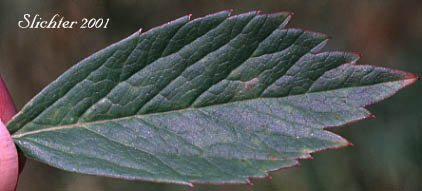 The photo at right shows
western water hemlock from the shores of the Columbia River near Dalton Point.
The photo at right shows
western water hemlock from the shores of the Columbia River near Dalton Point.
Western water hemlock is a perennial wildflower with erect, stout stems arising from 50-200 cm high. The one to several stems may root at the nodes and are hairless and often glaucous. The base of the stem is thickened and hollow with several horizontal partitions when viewed after cutting the stem lengthwise. The herbage of the leaves and stems is glabrous and glaucous.
The leaves are basal and are also found on the stems. They are once to thrice pinnately compound with the leaflets having serrate margins. The individual leaflet blades range from 3-10 cm long and 6-35 mm wide and are lance-linear to lance-ovate in shape. The main lateral veins which spread outwards from the central vein of the leaflet reach the margin in the notch between the teeth. See the leaflet photo below to see this characteristic as it is a useful way to distinguish this toxic species from the non-toxic ones that have the veins reach the leaflet margin at the tips of the teeth!
The inflorescence consists of a compound umbel with the 15-30 subequal rays 2-6 cm long. Bracts are either absent at the base of the umbel, or 1-3 narrow bracts may be present. Several linear to oblong bracts nearly as long as the pedicels may be found at the base of the umbellets. The pedicels are 3-8 mm long. The individual umbellets are rounded balls. The flowers are white or greenish and small in size. The fruits are round and about 2 mm long with low ribs.
All parts of t he western water hemlock are extremely poisonous to humans and cattle. Similar to some other species such as Angelica arguta, Angelica genuflexa, and Oenanthe sarmentosa, it can be distinguished from those species via the vein from the midrib of the leaflet which reaches the margin at the notch between serrations (See photo below.) and by the swollen base with horizontal partitions. To be safe, it would be best to refrain from eating any members of this family which grow in or near water.
Western water hemlock may be found growing in and along streams and rivers, in ditches and marshes, and in wet low or disturbed places. It may be found from the lowlands to mid-mountain elevations.
Western water hemlock may be found from Alaska south through the Pacific Northwest to southern California and Chihuahua, Mexico and eastward to Alberta and south through the Rocky Mts. to New Mexico.